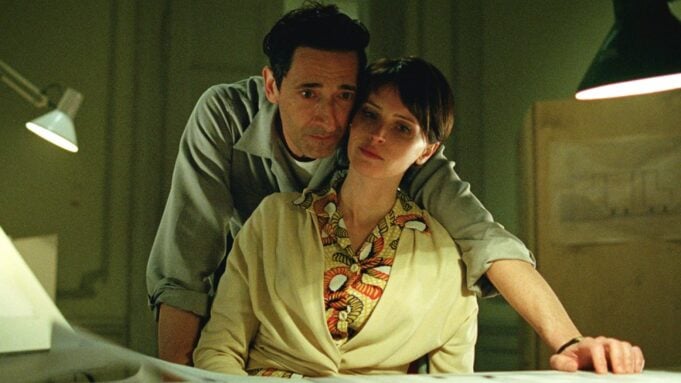Writer-director Brady Corbet doesn’t see much difference between constructing a skyscraper and making a movie.
“There are so many similarities,” says Corbet, whose new film “The Brutalist,” which dramatizes the concessions architects are forced to accept, is also an allegory of Hollywood. “We’re usually working for a client. The infrastructure involved is enormous. The number of people required to run these operations is immense, and there are so many compromises you have to make. There aren’t many art forms with so many cooks in the kitchen.”
“The Brutalist” is more concerned with constructing monuments than making movies, but its story seems to be informed by Corbet’s personal experiences with art and commerce. It centers on László Tóth (Adrien Brody), a Hungarian Jewish architect, who arrives in America after being interned at Buchenwald. His path intersects with that of a preening industrialist, Harrison Lee Van Buren (Guy Pearce), who enlists him to build a starkly modern community center. Tóth, at great cost to his mental, physical and financial health, insists on remaining true to his original inspiration for the building, even if that means sacrificing his own fee, while Van Buren is more interested in exerting his power.
“The relationship between a patron and an artist is a perverse one,” Corbet says as he sips coffee at a restaurant around the corner from his Boerum Hill apartment. “There are some extraordinary benefactors and companies that are ethical, but that’s rare. In general, it’s all about making you do more for less.”
The 36-year-old Corbet knows the movie business intimately, having “grown up on sets” as a child actor. Though he worked with masters like Michael Haneke on “Funny Games” and Gregg Araki on “Mysterious Skin,” he never felt comfortable on screen. “I was self-conscious. I never knew if I had nailed it.”
So as he entered his 20s, he moved behind the camera, directing two independent features, 2015’s “The Childhood of a Leader” and 2018’s “Vox Lux,” that examined the early life of a budding fascist and the career of a pop icon, respectively. His initial films were accomplished, often brilliant, but “The Brutalist” represents a dramatic step forward.
Critics hailed the movie as a masterpiece when it debuted at the Venice Film Festival; some compared its dark rumination on capitalism to that of “There Will Be Blood.” A24 bought the film and is planning a major Oscar push. Even if it doesn’t become an awards season darling, “The Brutalist” is indisputably one of the most audacious American independent films of this or any decade, boasting a run time of three and a half hours while telling a story that starts with American power at its postwar zenith and ends in the Reagan era. It was also shot in VistaVision, a large-format process popular in the 1950s, so it could be projected in 70mm like the screen epics of yesteryear. Oh, and it was all made for roughly $10 million — less than a tenth of what a major studio film costs.
Love Film & TV?
Get your daily dose of everything happening in music, film and TV in Australia and abroad.
“We cut every corner we could to make sure that every single cent was on screen,” Corbet says. “It was a Herculean effort, and I wouldn’t recommend it to anyone, because it was just years and years of essentially working for free.”
Well, seven years, to be exact. That’s how long Corbet struggled to cobble together financing, only to see the project collapse again and again. At one point, COVID restrictions scuttled plans to shoot in Europe; at another, the war in Ukraine prevented the filmmakers from shooting the movie in Poland, which shares a border. It would eventually be set up in Hungary, with postproduction taking place in the U.K. to take advantage of tax incentives. The process kept Corbet away from his family for 22 months. (Corbet has a 10-year-old daughter with Mona Fastvold, his partner and the film’s co-writer.)
“My next movie, I’ll probably shoot abroad,” Corbet says. “But postproduction has to be here. That’s nonnegotiable. Otherwise, I’ll never see my daughter grow up.”
Despite the challenges, Corbet didn’t dream of making “The Brutalist” on a big budget. “I never thought, ‘I wish I had $30 million more,’” he says. “There’s a lot of strings that come with that kind of money. It invites lots of opinions. You have all these executives who don’t trust the director and bury them in notes. What you get is something antiseptic that lacks a signature. It’s the difference between a bowl from Crate & Barrel and a wabisabi ceramic.”
Like the style of architecture referenced in its title, “The Brutalist” may be polarizing, but it is unmistakably the movie Corbet set out to make.
From Variety US































